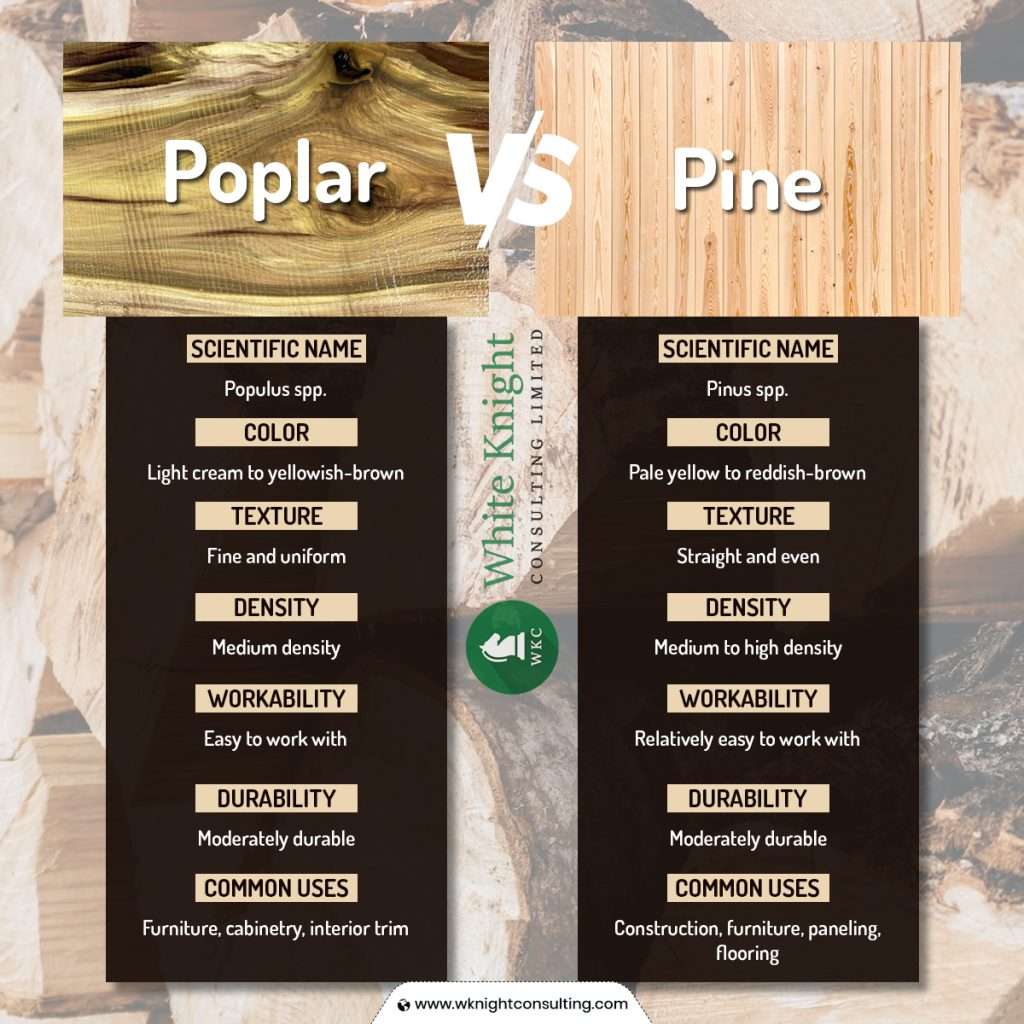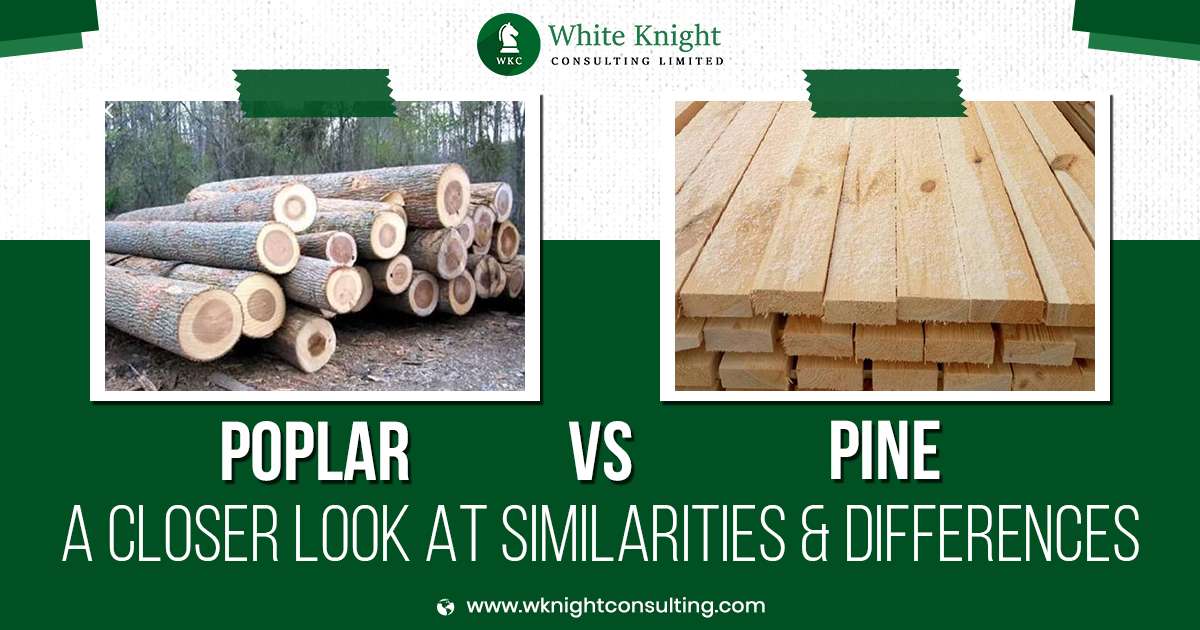Both poplar and pine are inexpensive and versatile wood options that can be seamlessly used for a wide range of woodworking applications.
The major difference between pine and poplar is that poplar is a hardwood while pine is a softwood. Despite being a hardwood, poplar is relatively soft and easy to work with timber, so it is often compared with pine wood, which is a strong and durable softwood.
Poplar and pine are two of the best inexpensive wood options for a range of woodworking projects, from furniture making to construction and outdoor projects (treated wood).
If you are confused between poplar vs pine for your next project, here’s everything you need to know about the two most popular commercial timber types.
Understanding Poplar Wood
Also called Tulip Poplar and Yellow Poplar, it is a hardwood most commonly found in the United States but also available in Europe and Asia.
Despite being a hardwood, Poplar is softer than most hardwoods. It is still hard enough to use in weight-bearing structures, plus it is easy to work with.
Poplar is harder than soft pine but softer than hard pine, which is also more expensive.
Poplar is one of the most popular utility woods around the world. It is used for furniture, plywood, paper, and crates.
Understanding Pine Wood
Pine has many species scattered all around the world. Western white pine, Eastern white pine, and longleaf pine are among the most popular pine wood species.
Western white pine is native to western North America. It is a beautiful, moderately durable wood that is prized for its workability.
Pine wood, widely recognized for its availability and cost-effectiveness, is highly regarded among woodworkers as one of the most popular softwoods. The distinct properties of pine wood make it an ideal choice for various woodworking projects. With its affordability and easy accessibility, pine wood stands out as a preferred option.
Pine is strong, moderately durable and very easy to work with. It looks beautiful in its natural state and also finishes very well. It is commonly used for furniture, plywood, veneer, carving, and construction.
Poplar vs Pine : Similarities
Poplar and pine woods look quite similar. Moreover, they are both easy to work with.
Both wood types have a soft structure. They’re both easily available and are rather inexpensive.
Both kinds of wood are easy to glue, nail, and screw and will not split when nailing.
Also, both poplar and pine usually have poor staining results, i.e. they stain poorly. While pine staining will result in blotching, poplar staining is uneven and looks unattractive.
Poplar vs Pine Wood : Differences

While there are a few similarities between poplar and pine, there are also many differences in terms of density, hardness, durability, and uses of pine and poplar woods.
Let’s start with the technical specifications of these two wood types.
Poplar vs Pine : Technical Specifications
| Poplar | Pine | |
| Average Dried Weight | 29 lbs/ft3 (455 kg/m3) | 27 lbs/ft3 (435 kg/m3) |
| Specific Gravity | .40, .46 | .35, .43 |
| Janka Hardness | 540 lbf (2,400 N) | 420 lbf (1,870 N) |
| Modulus of Rupture | 10,100 lbf/in2 (69.7 MPa) | 9,700 lbf/in2 (66.9 MPa) |
| Elastic Modulus | 1,580,000 lbf/in2 (10.90 GPa) | 1,460,000 lbf/in2 (10.07 GPa) |
| Crushing Strength | 5,540 lbf/in2 (38.2 MPa) | 5,040 lbf/in2 (34.8 MPa) |
| Shrinkage | Radial: 4.6%, Tangential: 8.2%, Volumetric: 12.7%, T/R Ratio: 1.8 | Radial: 4.1%, Tangential: 7.4%, Volumetric: 11.8%, T/R Ratio: 1.8 |
Appearance
Colour
Poplar has a light cream or yellowish-brown heartwood with green or grey streaks. The sapwood is a little lighter but not easily distinguishable. However, there are other poplar species available with colours ranging from black to light brown, and dark green.
Poplar is not a particularly attractive wood and is typically used in projects where the wood is not visible, such as upholstered furniture.
Pine is a beautiful wood with light brown heartwood that sometimes has a reddish hue. The wood colour becomes darker with age.
Grain & Texture
Poplar has a straight, uniform grain and a medium texture with a low natural lustre.
Pine texture ranges from fine to coarse. While sugar pine is coarse, Eastern white pine has a fine texture. While the grain in soft pines is uniform, hard pine species such as Loblolly Pine have uneven grains.
Physical Properties
Tree Specifications
Poplar is a deciduous tree that grows rapidly but has a short life. Due to fast growth, the wood is soft. Poplar trees are about 130-160 ft (40-50 m) tall and have a 6-8 ft (1.8-2.5 m) trunk diameter. The flowers in the poplar tree look similar to tulips.
Pine is a conifer tree which looks like a Christmas tree. It can be recognized by its needle-shaped leaves and pine cones. Pine trees are about 100-150 ft (30-46 m) tall and have a 3-5 ft (1-1.5 m) trunk diameter.
Wood Weight
Pine and poplar are almost equal in terms of weight. With an average dried weight of 435 kg/m3, pine is less heavy than poplar (455 kg/m3).
Hardness
Poplar has a Janka rating of 540 lbf, while that of pine is 420 lbf, which means poplar is harder than pine and will not dent or scratch as easily. However, there are some pine species, such as Longleaf pine, which are a lot harder than poplar.
Soft pine species are softer than poplar, while hard pines are harder. Hard pines can be as strong as many hardwood species. Shortleaf Pine, for instance, is nearly as strong as Red Oak.
Because pine is softer, long pine boards tend to sag when used as shelves.
Durability
Poplar is moderately durable in terms of resistance to rot and insects. It is not very hard or strong as it can get scratched and damaged easily.
Pine is a moderately durable wood, though it should not be used outside without treatment. Soft pine is susceptible to rot and insects, but hard pines are more durable and can resist rot and water damage for a long time.
Poplar vs Pine : Uses
Uses of Poplar Wood
Poplar is used in many applications. Because it is soft, it is often used for manufacturing paper (pulpwood) and crates. It is also sometimes used for making kitchen cabinets that can be stained to look premium. It can also be bent to make bowls, vases, etc. and is a popular choice for carving.
Other common uses of poplar wood include furniture, plywood, and veneering. The poplar wood sees application in pallets, crates, and the paper industry. It is also favoured for musical instruments including guitar bodies and drums, and is also used as a top for electric guitars. It is also favoured for crafting decorative items like photo frames and pocket watches.
Pine Wood Applications
Common uses of pine include furniture, flooring, window frames, plywood, panelling, and roofing.
Soft pines such as Western white pine are used for boxes, paper, matches, crates, veneer, and carving. Eastern white pine is also considered suitable for boat building because of its resistance to water. Sugar Pine, which is the weakest of all pines, is used for piano keys.
Hard pine species are used exclusively for the construction of subflooring, poles, roof trusses, piles, bridges, and beams. Caribbean Pine, which is also a type of hard pine, is used for flooring, plywood, and veneering. Western yellow pines, such as the Lodgepole pine, are used for cabinetry, construction, plywood, and crates.
Pressure-treated pine is used for outdoor construction, including decking and boatbuilding.
Workability, Availability & Price
Workability
One of the best things about poplar and pine is their workability.
Poplar is a soft hardwood that is very easy to work with. Sanding or planing can sometimes result in fuzziness on surfaces and sharp cutters may be required. It is easy to glue and takes nails and screws very well without splitting. Staining results are uneven and poor. It is also easy to carve and bend.
Soft pines are quite easy to work with both hand and power tools. They can be nailed and screwed easily and are easy to cut using a saw without any blunting or dulling of cutters. They are medium-weight and easy to handle. Pine is easy to glue, stain, and finish. It doesn’t swell or split easily. Hard pines can be slightly difficult to work with.
Availability
Almost all species of pine are easily available all over the world. Pine species are native to the US, Asia, and Europe. It is sustainable timber and not considered a danger to the environment.
Poplar is one of the cheapest types of hardwood. It is as easily and widely available as pinewood. It is sustainably sourced.
Price
Pine is usually more affordable than poplar, especially soft pine species. They are not only easily available but are cheaper than most hardwoods, including Poplar. Hard pines are more expensive though.
Poplar is also a cost-effective wood that is almost equal to or slightly more expensive than pine. Certain species, including Rainbow poplar, are quite rare and can be very expensive.
Buy Poplar and Pine Wood Timber Online
If you are looking to buy the best quality poplar hardwood or pine softwood with the convenience of online ordering and doorstep delivery anywhere in the world, you’re at the right place.
White Knight Consulting Ltd is your one-stop destination to buy all types of top-quality timber, hardwood and softwood from one of the world’s leading wood manufacturers, wholesalers & exporters. Now, you can order wood online from our website in custom sizes at wholesale prices and get it delivered to your address anywhere in Canada, Australia, Turkey, Poland, Spain, Vietnam, Albania, and other worldwide locations. Contact us to know more.
